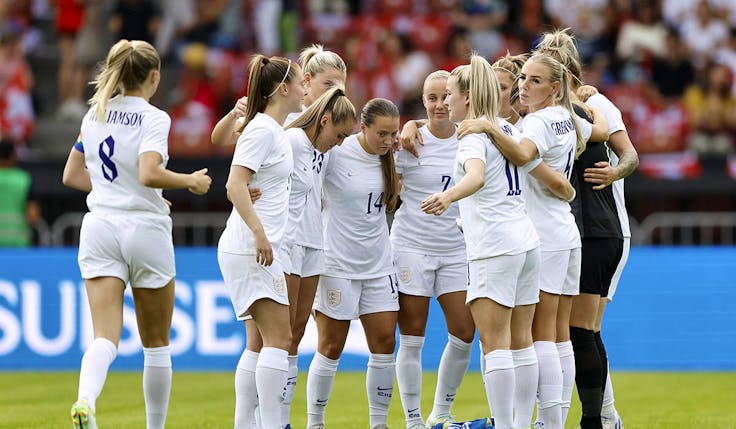Brands need to tackle their women’s sport creative barrier
Brands need to be bolder and stop only focusing on the negatives of the female experience when it comes to women’s sport marketing.
 Deloitte predicts women’s elite sports will be worth $1.28bn (£1bn) globally in 2024. The commercial opportunity is huge. Women’s sport is having its zeitgeist moment. Why? Because it’s getting the visibility it always deserved and a female narrative is emerging that women and girls are connecting with.
Deloitte predicts women’s elite sports will be worth $1.28bn (£1bn) globally in 2024. The commercial opportunity is huge. Women’s sport is having its zeitgeist moment. Why? Because it’s getting the visibility it always deserved and a female narrative is emerging that women and girls are connecting with.
Women’s sport is evolving rapidly, creating relevant, inclusive spaces and communities that women buy into, as players and fans.
But we’re not 100% there.
From discussions with sport organisations and brands we know there’s work to be done if the industry is going to unlock the big number Deloitte has predicted. There are fundamental questions that need to be answered around how to best secure significant investment, which comes back to understanding the rapidly evolving audiences, what an investable rights package looks like and how to commercialise the communities around women’s sport.
One of the biggest barriers that we hear whispered quietly by marketers is that brands know they should be doing more in women’s sport, but don’t know where to start.
The sport industry was designed by and for men. While the next generation is being brought up to support gender equality in sport, many still see the industry as a ‘boys sports club’. In marketing, some ads for sport still completely disregard the female fan or focus on stereotypical female issues, and many women’s campaigns still choose influencers over female athletes to deliver ROI.
Increasing visibility was the first step, but now the harder work begins to ensure that this moment in the sun is not fleeting, but sustainable.
One of the biggest barriers that we hear whispered quietly by marketers is that brands know they should be doing more in women’s sport, but don’t know where to start. They are afraid to say the wrong thing. There’s no shame in that; it’s an emerging industry that is moving fast.But brands must act to not miss this once in a generation opportunity.
Brands aren’t doing enough, yet
Women’s sport needs brands to help create era defining, sustainable campaigns.
It’s tough to say, but we are still waiting for those era defining moments. Not since ‘This Girl Can’ in 2015 can we recall any women’s sport creative that has captivated the nation. What’s sad is that the world is waiting with bated breath for it. People want to write about women’s sport, to share great women’s sport content, to celebrate its athletes, but we haven’t hit the spot yet.
Core to sustainability is brand support. Many sports organisations are facing a tremendous time of change. Most have spent the last century selling their sport to men who, by and large, have bought it. Now they are having to regroup and reorganise themselves around the business need to sell women’s sport. Same product, but a different proposition, often much less budget.
Or they may be a women’s sport who are turning professional, having to demonstrate that they can fill stadiums on a regular basis and asking for unprecedented commercial deals to help make that a reality.
This is where brands can have a valuable role in helping sport make a shift. Brands understand audience segmentation, media channels, creativity and customer engagement, and we need them to bring this to the table.
Record-breaking views for women’s sport in 2023, data shows
Women’s sport is as far from a badging exercise as you can get. The opportunity to integrate your brand into sport and create a lasting legacy is there for the taking.
Brands like Barclays, O2 and Vitality have successfully leaned into this role. And now there is the emergence of newer brands such as Kim Kardashian’s shapewear label Skims, Gucci and make-up brands Il Makiage and Charlotte Tilbury, which have seen the opportunity to have a fresh take on sports partnerships.
This list should be longer. What is holding brands back?
It’s the lack of understanding of the audience and the culture surrounding them. For some reason the audience for women’s sport is a mystery. Many may excuse the lack of audience clarity because of how quickly it is evolving and growing – but that’s not really a good enough excuse to not dig into the numbers.
More than half (51%) of ticket holders for the 2022/23 season at Arsenal Women were under 35, according to Women’s Sport Trust research. In many ways women’s sport is what the future of sport will look like.
With this younger generation it feels like women’s sport is shaking off the challenges of the past. Being fans of women’s sport, playing girl’s sport, is all starting to feel incredibly relevant and accessible. Now you can be a fan on your own terms, discovering women’s sport through different sporting and cultural touchpoints. Cue Caitlin Clark, Coco Gauff, Leah Williamson and Sky Brown.
And this is coming to life through new avenues. Naomi Osaka and her creative house Hana Kuma, the new podcast Tooney and Russo Show, documentaries such as Surf Girls Hawaii from Reese Witherspoon’s production company Hello Sunshine.
Not just family friendly fun
However, brands and product owners are still eager to tell us that women’s sport is a family day out.
If you go to watch women’s sport you will see it clearly, an emerging group of women between 18 and 30, connecting around sport and creating their own subcultures within this inclusive, celebratory community. And moving forwards we believe this youth audience will increasingly become gender neutral.
This is not the family audience that is often touted as the big opportunity in women’s sport.
If we had £1 for every time we’ve been told face painting will be the saviour of the women’s match day experience, we could fill our WSL Panini sticker book a little faster. Families are indeed an audience of women’s sport, but not the only audience. Frankly, families are busy and it’s hard to get them to commit. Are they going to be the ones supporting on a rainy February evening during term-time?
Women’s sport has a creative barrier, propped up by its reliance and focus on the negative stories. In a world where every creative brief seemingly needs a tension, a problem to solve, the tendency has been to use that as the hook.
The fact is there is a beautifully complex and inclusive audience to be had in women’s sport, but it takes a little time to understand it.
The match day experiences are evolving, and we would task any brand director to go along and see women’s sport live. It’s exciting and distinct. There are so many opportunities to leverage here beyond the usual perimeter boards and hospitality.
The fans want a whole experience, free from the match day rituals that dictate men’s sport. Experiential marketing that encourages social content creation and sharing could be used brilliantly here, but still, we’re yet to see a brand showcase excellence in this area.
Why so serious?
Women’s sport has a creative barrier, propped up by its reliance and focus on the negative stories. In a world where every creative brief seemingly needs a tension, a problem to solve, the tendency has been to use that as the hook. Girls falling out of sport, periods, body issues, ACL injuries.
Brands keep telling girls to dream big. But as marketers, we need to take that advice ourselves.
Undoubtedly there is a role for some brands to focus on these issues, but why are we using our media money to amplify the problems rather than inspiring our audience with what is great about women’s sport? Girls deserve more than to be told how different they are and how hard it is for them.
There are more women and girls playing sport than ever before, so let’s celebrate them. Girls don’t have to justify their interest; they can just play. Sport is fun, joyful, you make friends for life. It’s competitive and it provides the best memories.
There are brilliantly different body types, unbelievable role models and a community of like-minded people to discover. Girls growing up now will only know women’s football and other sports being professional. They can see their idols on TV, follow them on social media and meet them at the games.
It’s important to know and not forget where we’ve come from, but in this era we need to move the narrative forward. Women’s sport can no longer be the perpetual runner-up to the men’s game.
Some clients are warehousing their women’s sport rights because they don’t know what to do with them. Brands activating in men’s sport should understand how they can pivot and bring in different channels for this new and exciting audience. We urge brands to enter the space and offer a fresh take on women’s sport today and moving forward.
Laura Weston and Jules Hilson are cofounders of new women’s sport consultancy See You at Jeanie’s. Weston led the agency that launched the Women’s Super League and has worked in sport marketing for 25 years. With 20 years’ experience, Hilson previously worked as executive creative director for Puma’s agency, MSL.




